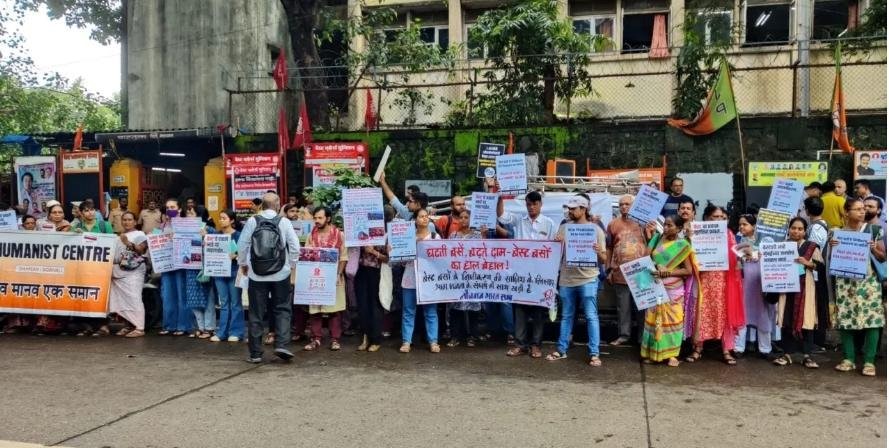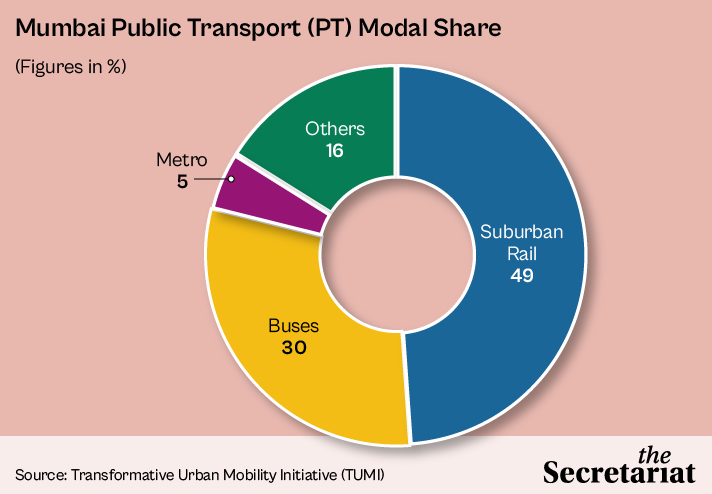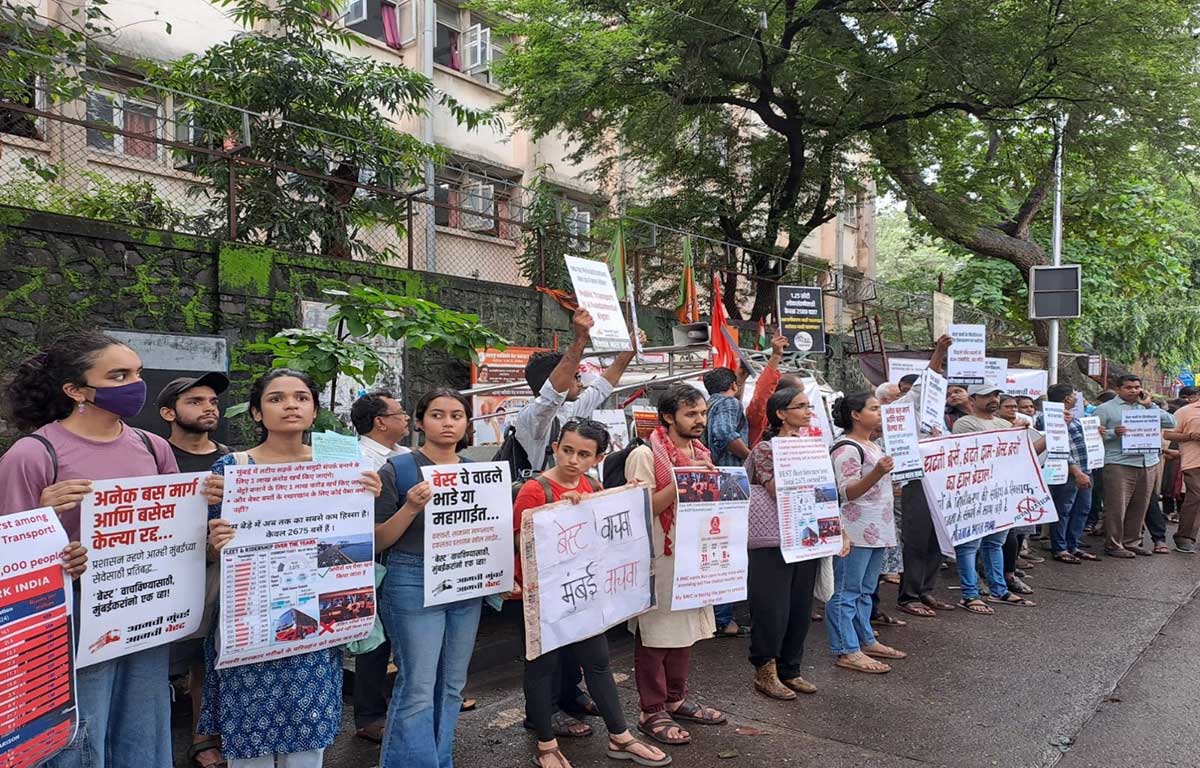Citizens’ demands: July 4, 2025 protest
On July 4, 2025, hundreds of students, parents, regular BEST commuters, old, young, activists from Aamchi Mumbai Aamchi BEST, Fridays For Future Mumbai, Habitat and Livelihood Welfare Association, Humanist Centre, Jan Haq Sangharsh Samiti, Lokraj Sanghatana, Loktantrik Kamgar Union, Mulbhut Adhikar Sangharsh Samiti, Nagari Niwara Vichar Manch, Naujawan Bharat Sabha, Nivrut Kamgar Sanghatan, Pudhe Chala and Purogami Mahila Sanghatana gathered at the Mumbai, Wadala depot, demanding that, public transport is an issue of survival and livelihood for most of the commuters and hence, Mumbai’s lifeline BEST (public bus transport) service be considered as inviolable right of citizens.
They collectively submitted their demands to BEST authorities, the major demands being:
- The fare hike be immediately rescinded and restored to earlier levels.
- The decision to monetise depots be cancelled and BEST land be retained exclusively for BEST’s use.
- The February 2024 decision of the Municipal Commissioner be implemented so the BEST can henceforward be subsidised and operated as part of the BMC Budget.
- BEST discontinues wet-leasing and immediately purchase and operate its own buses to maintain a fleet of at least 6000 buses to meet the needs of commuters in the city.
Several activists and leaders addressed those Mumbaikars who had gathered. Speakers maintained that public transport is an inviolable right of citizens of the city. For decades. The BEST bus service has been a lifeline for the people of Mumbai, as it ensured that working people can travel to work, to schools and colleges, to hospitals, and for other needs of city life with safety, efficiency, and affordability. That is why Mumbaikars once used to love BEST as their own.

However, of late, over the past few years, in the name of “cutting losses,” BEST has increasingly brought in private contractors, doubled bus fares, reduced the bus fleet, and have thereby deepened the crisis — and it is the ordinary Mumbaikar who is paying the price.
Many commuters, including parents who drop and pick up children from school, students travelling to colleges and universities, patients travelling to public hospitals spoke about how doubling of the fare has led to major increase in their expenses and how they are finding it difficult to cope. The average daily BEST ridership dropped by at least 10%, after the fare hike, (nearly doubled) on May 9, 2025.[1]
One senior trade union leader Mr Ranga Satose, in fact, informed the protestors as to how Maharashtra Government has decided to monetise BEST properties, under the pretext of losses incurred. He said, that “Deputy Chief Minister Mr. Eknath Shinde held meeting in month of April 2025, and has decided to monetise all BEST assets, which includes 375 acres land.”
BMC the richest civic body in India, with ₹74,427 crore budget[2] for year of 2025: Public transport is not profit-making venture but the citizens’ right to affordable transportation
The Brihanmumbai Municipal Corporation (BMC) estimates a revenue income of Rs 43,159.40 crore for the fiscal year 2025-26, according to the Free Press Journal. This figure represents a 20.73% increase compared to the revised estimates for the previous year.[3] The BEST transport division’s losses were covered by the more lucrative electricity division till 2017. But following a court order in November 2016, the cross-subsidy to the transport division came to halt.
Wet leasing: Contractualisation proposed to reduce losses
In 2018, BEST introduced wet leasing. Sudas Sawant, Public Relations Officer of BEST, explained that under the wet-leasing arrangement, contractors own and operate buses, and are also responsible for staff recruitment, fuel and maintenance of buses. In return, BEST pays the contractors a fixed amount per kilometre of transport.[4]
However, to the contrary, contractualiastion has led to further losses, along with an increase in accidents, poor and irregular service. The cost recovery index (according to annual operational and financial data of BEST) which was 2013-14 60 % has gone down to 25 % in 2022-23 (After introducing PPP model of wet leasing)
The memorandum submitted by the organisations clearly reveals the problem created by wet leasing.
2021 and 2022 – There was a justified strikes of wet-lease workers for the non-payment of wages in various depots, including Mumbai Central, Magathane, Kurla, Vikhroli, Wadala, and Bandra. This caused hundreds of buses at a time to be taken off the roads and led to widespread suffering by commuters. In September 2022 the BEST general manager himself sent a letter to the MP group of contractors reprimanding them for the frequent strikes by staff and for the frequent breakdowns.
2022 and 2023 – Due to improper maintenance, there were fires in a number of buses, including in Bandra, Andheri and Kandivali. As a result, in February 2023 the BEST management took 400 wet leased buses off the roads, again resulting in distress for commuters.
August 2023 – Again a massive justifiable strike of BEST wet-lease workers was called –workers ‘employed’ by different contractors– for various demands including a living wage. Over 1,000 buses were off the roads for seven days, disrupting the life of the city. The workers ended the strike on some assurances by the Government, but these were not fulfilled.
Of the 2,100 electric buses to be supplied by the private contractor Evey to BEST by August 2023, only 185 were supplied, a year after the deadline.
The real purpose behind Contractualisation: Selling family silver
The BEST did not diminish itself; it was deliberately done in.
In 2011-12, it was a proud public utility with a fleet of 4,700 buses ferrying 4.2 million a day. By 2023, its fleet was barely 2,964 with 3.5 million commuters; importantly, less than a third of the fleet was owned and operated by the BEST as the wet lease model took hold. In May 2025, only a fifth of the 2,600 buses were owned by the organization. The BEST-owned bus fleet has dipped to its lowest-ever at 795 buses. With 60-70 buses being phased out every month, the fleet will become zero this year or by early next year.[5]
The memorandum submitted by the organisations’ states that:
“The wet-lease model has already proved to be an unmitigated failure for BEST. Even with a largely privatised fleet, the transport division recorded a loss of Rs 2,160.17 crore in 2022–23. This model has also imposed social costs—ranging from service breakdowns and accidents to increased wait times and falling ridership,”
“Private contractors often compromise on safety and maintenance to boost profits. The result: more breakdowns, bus fires, and fatal accidents. Drivers are overworked, underpaid, and frequently untrained, putting passengers at risk. The experience of wet leasing has been negative for both commuters and workers. Fares have surged without delivering any tangible benefits. Service quality has deteriorated, especially in low-income areas. Long routes have been cut, leaving passengers stranded and forcing them to switch buses or transport modes—raising commute time and costs,”
The cumulative losses of BEST stand at around Rs 9,300 crore.[6] To make good, the organisation intends to sell or pawn its family silver – land parcels totalling more than 126 hectares, some at prime locations, across Mumbai. Back in 2017, incidentally when the privatisation began, international consultants PwC had valued the land at Rs 5,170 to Rs 6,160 crore, citizens’ groups point out. A few of its 27 bus depots have been monetised. Commercial developers have constructed plush towers; Mumbai got nothing from the public land. In a city rapidly privatising land, this fits the larger agenda.[7]
Complete disregard for Public Transport: complete lack of planning or feasibility studies
Local Railway
The average number of daily commuters on the western, central and harbour lines stood at 7.06 million[8]. In local railways due to massive overcrowding, nearly 7 persons get killed and another 7 persons, on an average, are injured daily.[9] There has been no attempt to improve the signalling system or introduce additional lines for local trains.
On June 9, 2025, near Mumbra five commuters lost their lives, when two overcrowded two trains passed each other in opposite direction.[10] As a knee jerk reaction, Central Railway wants 800 Mumbai offices to change their work hours: Changing office timings will make it possible to manage crowds and make train journey of Mumbaikars safer, CR’s letter says[11]
Introduction of AC local trains: added disaster
Currently, CR operates 66 air-conditioned local train services in the Mumbai suburban section on weekdays, out of a total of 1,810 suburban services.
In a recent affidavit submitted to the High Court by Central Railways, highlights that the introduction of AC trains has led to a reduction in the capacity to run similar trains for similar destinations compared to non-AC trains. The affidavit further states that the door-closing and opening process of AC trains takes additional time, reducing the number of trains that can be operated on the same route.[12] Due to time constraints many non-AC commuters are forced to travel in AC trains and according to July 9, 2025 Loksatta, the railways have fined such commuters in just last 8 months to the tune of 63 lakhs.
Unplanned introduction of Electric bikes: No feasibility study undertaken
In clear indication of shirking the responsibility of providing affordable public transport, the State government has given green signal to private two wheelers taxis, adding further to traffic vows. On July 4, the state government notified the Maharashtra Bike-Taxi Rules, 2025, clearing the way for app-based aggregators to begin operations.[13]
Using public money and providing all the transport facilities at no cost to the richest of the city and country.
The Coastal road which is 8-lane, 29.2 km long road, which is developed at the cost of 13000-14000 crores, serves only private vehicles and taxis. Ordinary people availing public transport cannot use it. Still such an enormous amount of money is poured into it.
The Samruddhi Mahamarg expressway project in Maharashtra is estimated to have cost ₹55,000 crore. This 701-kilometer expressway aims to significantly reduce travel time between Mumbai and Nagpur, cutting it from 16 hours to approximately 8 hours. Western Dedicated Freight Corridor. Furthermore, some districts throughout the Expressway will receive easy access to Jawaharlal Nehru Port Trust. It is also being promoted by Adani Reality.
The estimated cost for the Western Dedicated Freight Corridor (WDFC) is Rs 72,000 crore. This project is part of a larger nationwide logistics overhaul, with the total cost of the Dedicated Freight Corridor (DFC) project estimated at Rs 1.24 lakh crore. The WDFC connects Khurja to Jawaharlal Nehru Port in Maharashtra.
The “Shaktipeeth Expressway,” a proposed 802 km, six-lane, access-controlled expressway, estimated to cost ₹86,300 crore, aims to connect Nagpur with Patradevi on the Goa border, traversing 12 districts. This route is designed to facilitate the trade of Goa’s coal and minerals for two industrialists, Mr. Ambani and Mr Adani, to allow them to exploit the abundant minerals found in Konkan. Farmers are protesting, fearing displacement and loss of fertile agricultural land. But the project is still on.
Development of Metros at enormous cost: non-affordable transport
Mumbai’s first-ever underground Metro is expected to begin operations in a phased manner starting in October, according to state agency officials. The Rs 37,276 crore project is likely to become fully operational in 2025.[14]
Mumbai’s metro network is set for a major expansion with MMRDA’s Rs. 10,970 crore budget for FY 2025–26.[15]
Mumbai’s Metro, once seen as the key to solving the transport chaos of the sprawling metropolis, is faltering with low ridership, high costs and poor integration — demanding a seamless approach to transform urban mobility[16]
Metro tickets ranging from Rs 10 to Rs 60 for a trip, with no season ticket subsidy is not an affordable mode of transport foe majority of working people in Mumbai.

The BEST buses constitute an essential and vital public service that keeps Mumbai moving and urgently needs to be supported through budgetary grants. Public transport must not be run for profit. Measures to improve efficiency and financial sustainability should serve the objective of increasing ridership, and not undermine it. Fare hikes, privatisation and land sales are ruinous for Mumbai and its common citizens.
(The author is an activist with Aamchi Mumbai Aamchi Best, a citizens network)
[1] https://timesofindia.indiatimes.com/city/mumbai/best-daily-ridership-drops-10-as-officials-fear-more-may-migrate-to-other-modes/articleshow/121170354.cms
[2] https://www.hindustantimes.com/cities/mumbai-news/brihanmumbai-municipal-corporation-presents-rs-74-427-crore-budget-for-202526-101738660999780.html
[3] https://www.financialexpress.com/budget/bmc-budget-2025-live-updates-mumbai-municipal-budget-2025-allocations-for-all-sectors-3736971/#:~:text=As%20of%20December%2031%2C%202024,revised%20estimate%20for%202024%2D25.
[4] https://citizenmatters.in/mumbai-public-transport-best-bus-contract-issues/
[5] https://questionofcities.org/mumbais-best-is-being-killed-the-political-will-to-revive-it-is-absent/
[6] https://www.hindustantimes.com/cities/mumbai-news/bests-losses-mount-from-6-400-crore-to-9-200-crore-in-2-years-101732821142988.html
[7] https://questionofcities.org/mumbais-best-is-being-killed-the-political-will-to-revive-it-is-absent/
[8] https://www.hindustantimes.com/cities/mumbai-news/suburban-railway-ridership-inches-back-to-pre-pandemic-levels-101730056826516.html
[9] https://www.hindustantimes.com/cities/mumbai-news/7-people-lose-their-lives-on-railway-tracks-in-mumbai-every-day-101749496588283.html
[10] https://www.hindustantimes.com/cities/mumbai-news/mumbra-train-incident-accident-exposes-deadly-commuting-crisis-on-central-railway-101750531475489.html
[11] https://www.news18.com/cities/central-railways-requests-800-mumbai-offices-to-change-work-hours-to-reduce-crowding-on-trains-ws-kl-9427653.html
[12] https://www.freepressjournal.in/mumbai/mumbai-ac-local-trains-reduce-capacity-for-additional-services-in-suburban-section-cr-affidavit-reveals
[13] https://indianexpress.com/article/cities/mumbai/electric-bike-taxis-now-legal-in-maharashtra-heres-what-the-rules-say-10114038/
[14] https://www.business-standard.com/india-news/mumbai-s-first-under-ground-metro-to-start-partial-operations-next-week-124092501001_1.html
[15] https://railanalysis.in/rail-news/mmrda-allocates-around-rs-10970-crore-for-metro-projects-in-fy-2025-26-budget/
[16] https://thesecretariat.in/article/metro-is-falling-short-mumbai-needs-multi-modal-transit
Related:
Citizens and experts rally to save Mumbai’s BEST buses from privatisation pitfalls
BEST strike over Diwali bonus shakes Mumbai’s Bus Service, reveals growing transit strain

